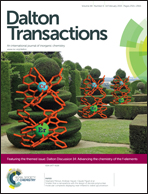New insights into the nitroaromatics-detection mechanism of the luminescent metal–organic framework sensor†
Abstract
Luminescent metal–organic frameworks (LMOFs) have emerged as a group of new and very promising optic sensors in the detection of explosives. However, fundamental understanding of the sensing mechanisms on these materials is still immature and detailed investigations are needed. In this contribution, density functional theory (DFT) and time-dependent density functional theory (TD-DFT) are applied to reveal the underlying principles for the sensing mechanism by comprehensively studying the analyte–sensor interactions. Three molecules namely nitrobenzene, benzene and acetone are chosen as analytes while a newly reported explosives-detecting LMOF [Zn2(L)(bipy)(H2O)2]·(H2O)3(DMF)2 is chosen as the sensor. Roles of two fundamental weak interactions namely hydrogen bonding interaction and π–π stacking interaction are clarified for the first time. By studying both the periodic crystal models and cluster models we obtained an in-depth understanding of the detecting mechanism from the view of electronic coupling. We find that intermolecular electron transfer is the inducement for the luminescence quenching detection of explosives. A brand new pathway for this electron transfer process is proposed for the first time. Most significantly, we discover that the hydrogen bond shows multi-functions during the detecting processes which, on the one hand, serves as the electron transfer bridge, and on the other hand, reinforces the π–π stacking. This cooperative effect of the two weak forces inside MOFs is investigated for the first time, which not only provides valuable insights into the understanding of the analyte–sensor interactions inside the sensors but also offers useful guidance in the design of MOF sensors to achieve high sensitivity.


 Please wait while we load your content...
Please wait while we load your content...